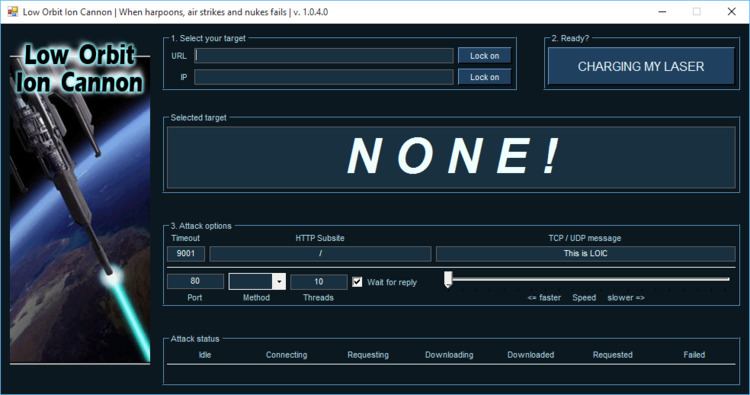Original author(s) Written in C# | Development status Discontinued | |
 | ||
Stable release 1.0.8 / December 13, 2014; 2 years ago (2014-12-13) Operating system | ||
Low Orbit Ion Cannon (LOIC) is an open source network stress testing application, written in C#. LOIC was initially developed by Praetox Technologies, but was later released into the public domain, and now is hosted on several open source platforms.
Contents
Use
LOIC performs a DoS attack (or when used by multiple individuals, a DDoS attack) on a target site by flooding the server with TCP or UDP packets with the intention of disrupting the service of a particular host. People have used LOIC to join voluntary botnets.
The software inspired the creation of an independent JavaScript version called JS LOIC, as well as LOIC-derived web version called Low Orbit Web Cannon. These enable a DoS from a web browser.
Countermeasures
Security experts quoted by the BBC indicated that well-written firewall rules can filter out most traffic from DDoS attacks by LOIC, thus preventing the attacks from being fully effective. Specifically, it has been claimed that filtering out all UDP and ICMP traffic helps to effectively address LOIC attacks. Because internet service providers provide less bandwidth to each of their customers in order to provide guaranteed service levels for all of their customers at once, firewall rules of this sort are more likely to be effective when implemented at a point upstream of an application server's internet uplink. In other words, it is easy to cause an ISP to drop traffic destined for a customer by sending a greater amount of traffic than is allowed on that customer's link, and any filtration that occurs on the customer side after the traffic traverses that link will not stop the service provider from dropping excess traffic destined for that customer.
LOIC attacks are easily identified in system logs, and the attack can be tracked down to the IP addresses used at the attack.
Project Chanology and Operation Payback
LOIC was used by 4chan during Project Chanology to attack websites from the Church of Scientology, once more to (successfully) attack the Recording Industry Association of America's website in October 2010, and it was again used by Anonymous (group) during their Operation Payback in December 2010 to attack the websites of companies and organizations that opposed WikiLeaks.
Operation Megaupload
In retaliation for the shutdown of the file sharing service Megaupload and the arrest of four workers, Anonymous DDoSed the websites of UMG (the company responsible for the lawsuit against Megaupload), the United States Department of Justice, the United States Copyright Office, the Federal Bureau of Investigation, the MPAA, Warner Brothers Music and the RIAA, as well as the HADOPI, all on the afternoon of January 19, 2012, through LOIC.
Origin of name
The LOIC application is named after the ion cannon, a fictional weapon from many sci-fi works, and in particular after its namesake from the Command & Conquer series of video games.
